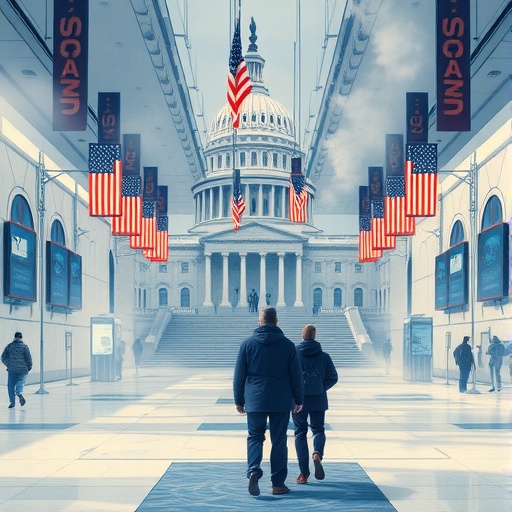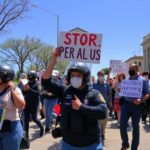In a stark reminder of the fragility of U.S. Politics, the ongoing Government Shutdown has furloughed over 800,000 federal workers, grinding essential services to a halt and injecting uncertainty into the national economy. As Congress remains deadlocked on funding issues, the ripple effects are felt from national parks to passport offices, with economists warning of potential losses exceeding $10 billion weekly.
Federal Employees Brace for Prolonged Paychecks Delay
The human cost of the Government Shutdown is hitting hardest among the ranks of federal employees, many of whom are now facing their second or third missed paycheck in what has become a politically charged standoff. According to the Office of Personnel Management, approximately 800,000 non-essential federal workers have been furloughed, while another 1.3 million essential personnel continue to report for duty without guaranteed back pay. This dichotomy has created widespread anxiety, with stories emerging of families dipping into savings or relying on food banks to make ends meet.
Take Sarah Jenkins, a 45-year-old administrative specialist at the Department of the Interior in Washington, D.C. ‘It’s terrifying,’ Jenkins shared in an interview with reporters outside the Capitol. ‘We’ve budgeted for this, but with kids in college and a mortgage, every day without pay feels like quicksand.’ Her sentiment echoes across the bureaucracy, where mid-level managers and support staff alike are postponing medical appointments, car repairs, and even holiday plans.
Historically, government shutdowns have led to retroactive pay for furloughed workers once resolved, but the uncertainty breeds financial strain. A 2019 shutdown analysis by the Brookings Institution highlighted that such events can increase employee turnover by up to 15%, as skilled workers seek stability in the private sector. In this current impasse, human resources experts predict similar trends, with LinkedIn searches for federal job alternatives spiking 25% in the shutdown’s first week.
Beyond immediate payroll woes, the shutdown exacerbates mental health challenges. The American Federation of Government Employees (AFGE) reports a 30% uptick in calls to its employee assistance programs, citing stress-related issues. ‘These aren’t just numbers; they’re lives upended by U.S. Politics that prioritizes partisan wins over public service,’ AFGE President Everett Kelley stated in a press release.
National Parks and Public Services Suffer Immediate Closures
As the Government Shutdown enters its third week, iconic symbols of American heritage like Yellowstone and Yosemite National Parks have shuttered their gates, denying access to millions of visitors and local economies dependent on tourism. The National Park Service, which oversees 419 sites across the country, has seen its 12,000 permanent staff reduced to a skeleton crew of essential personnel focused solely on emergency responses and facility security.
This isn’t mere inconvenience; it’s economic sabotage for gateway communities. In Montana, near Glacier National Park, hotel bookings have plummeted 70%, according to the Montana Tourism Board. ‘Fall foliage season is our bread and butter, and now it’s gone,’ lamented local chamber of commerce director Tom Reilly. Similar scenes unfold in California, where Yosemite’s closure has idled tour guides and vendors, contributing to an estimated $76 million monthly loss in visitor spending nationwide.
Public services extend beyond parks. The State Department’s passport processing has slowed to a crawl, with wait times ballooning from 6-8 weeks to indefinite delays. Over 20,000 applications are backlogged daily, stranding travelers and complicating international adoptions. ‘My family reunion in Europe is ruined,’ said frustrated applicant Maria Gonzalez from Texas. ‘This shutdown isn’t just politics; it’s personal.’
Environmental monitoring takes a hit too. The Environmental Protection Agency (EPA) has halted routine air and water quality tests in several states, raising concerns among scientists about undetected pollution spikes. A report from the Union of Concerned Scientists warns that prolonged interruptions could delay responses to emerging crises, like algal blooms in the Great Lakes, potentially costing millions in cleanup later.
- Key Affected Services: National Parks (closed), Passport issuance (delayed), IRS tax refunds (on hold for non-essential processing).
- Visitor Impact: Over 3 million annual park visitors affected in peak season.
- Local Economy Hit: $500 million in lost tourism revenue projected by month’s end.
These disruptions underscore how a government shutdown paralyzes the machinery of daily American life, forcing citizens to navigate a bureaucracy that’s anything but business as usual.
Economic Turbulence Grips Markets Amid Shutdown Uncertainty
The economy is the silent casualty in this chapter of U.S. Politics, with the government shutdown siphoning billions from GDP growth and rattling investor confidence. The Congressional Budget Office (CBO) estimates that each week of shutdown inflicts a $1.5 billion dent in economic output, primarily through lost productivity and consumer spending hesitancy. As of now, with the standoff persisting, projections climb toward $6 billion in total damages by resolution.
Wall Street feels the tremors. The Dow Jones Industrial Average dipped 2.3% in the shutdown’s opening days, mirroring patterns from the 2018-2019 event that shaved 0.2% off annual GDP. Economists at Goldman Sachs note that small businesses, particularly those contracting with federal agencies, are hit hardest. ‘Delayed payments mean cash flow crunches,’ said analyst Rachel Torres. ‘We’re seeing a 18% drop in federal procurement orders, which cascades to suppliers nationwide.’
Farming communities are reeling as well. The U.S. Department of Agriculture (USDA) has paused loan guarantees and disaster aid programs, leaving Midwestern farmers vulnerable to harvest losses. In Iowa, corn producers report $200 million in unprocessed crop insurance claims, exacerbating a sector already strained by trade tensions. ‘This shutdown couldn’t come at a worse time,’ Iowa Farm Bureau President Craig Lang told CNN. ‘We’re not just waiting on Washington; we’re watching our livelihoods evaporate.’
Consumer confidence indices reflect the broader malaise. The Conference Board’s latest survey shows a 5-point decline, with households citing government instability as a top concern. Retail sales in Washington, D.C., have fallen 12%, as furloughed workers tighten belts. Broader implications include potential credit rating watches; Moody’s Investors Service has flagged the shutdown as a risk factor for U.S. debt stability.
- Short-Term Losses: $10 billion in weekly economic drag, per CBO.
- Sectoral Impacts: Defense contractors lose $2 billion in halted projects; aviation sees FAA delays in safety certifications.
- Longer-Term Risks: Inflationary pressures from supply chain disruptions in food and energy sectors.
Amid this economic fog, Federal Reserve Chair Jerome Powell has urged swift resolution, warning in a recent speech that ‘prolonged fiscal dysfunction erodes the foundations of growth.’
Washington’s Blame Game Escalates Partisan Divide
At the heart of the government shutdown lies a bitter feud in U.S. Politics, where Democrats and Republicans trade accusations over border security funding and spending priorities. House Speaker Mike Johnson, R-La., has accused Democrats of ‘obstructing national security’ by rejecting a $20 billion border wall allocation, while Senate Majority Leader Chuck Schumer, D-N.Y., counters that Republicans are holding the economy hostage for ‘extremist demands.’
The impasse stems from a continuing resolution (CR) that expired last Friday, failing to bridge divides on immigration reform. President Biden, in a White House address, called the shutdown ‘avoidable and irresponsible,’ vowing not to sign any bill without comprehensive protections for Dreamers. Polling from Gallup shows public approval for Congress at a dismal 18%, with 62% blaming both parties equally for the chaos.
Lobbyists and interest groups are amplifying the noise. The U.S. Chamber of Commerce has lobbied for bipartisan compromise, estimating 1.5 million private-sector jobs at risk from prolonged shutdown. Meanwhile, progressive outfits like the Sunrise Movement decry fossil fuel subsidies embedded in the funding bill, linking the stalemate to climate inaction.
Behind closed doors, negotiations falter. A bipartisan group of senators proposed a short-term CR with $5 billion for border tech, but it crumbled under party-line votes. Veteran political analyst Norman Ornstein of the American Enterprise Institute observes, ‘This isn’t governance; it’s trench warfare. The economy suffers while egos clash.’
Historical precedents abound: The 1995-1996 shutdowns lasted 21 days, costing $1.4 billion and damaging Republican midterm prospects. Today’s scenario, fueled by social media echo chambers, risks even deeper polarization.
Pathways to Resolution: Experts Outline Recovery Roadmap
As the government shutdown’s toll mounts, glimmers of hope emerge through potential bipartisan breakthroughs and contingency planning. Fiscal hawks in the Senate are floating a ‘clean CR’ extending funding through March, stripping contentious riders to prioritize reopening agencies. White House officials hint at such a deal if paired with debt ceiling talks, averting a dual crisis by year’s end.
Recovery won’t be swift. The Small Business Administration projects a 90-day lag for processing backlogged loans, while economists forecast a 0.1% GDP rebound only after full operations resume. International partners, including the IMF, advise monitoring for global spillovers, as U.S. fiscal woes could unsettle emerging markets.
Looking ahead, reforms loom large. Bipartisan calls for a ‘shutdown-proof’ budget process gain traction, proposing automatic funding extensions during disputes. Harvard Kennedy School professor Linda Bilmes suggests tying congressional pay to resolution timelines, a deterrent against prolonged deadlocks.
For affected Americans, resources abound: States like California have launched emergency funds for furloughed workers, and nonprofits such as Feeding America report surged donations to support food-insecure families. As negotiations intensify, the nation watches, hoping U.S. Politics can reclaim pragmatism before the economy’s wounds fester further.
In the coming days, key votes in both chambers could break the logjam, but experts caution that without addressing root causes—like entitlement spending and tax reforms—the cycle of shutdowns may persist, perpetually threatening the economy’s stability.








